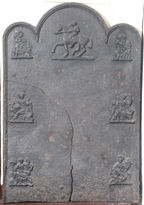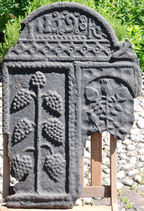-
418
Description: Cavetto-arched rectangular central panel with bead-and-pellet edging, head and robed shoulders of a laureated man in left profile; cavetto-arched rectangular border with cavetto-moulded edging and arrangement of outward-facing acanthus leaves; on top, scallops on shoulders of border with cornucopiae over arch.
Notes: A pastiche of the 'Dutch' style of fireback. Formerly part of the J. H. Every collection.
- Decoration tags:
- 'Dutch' (shape)
- bead-and-pellett (edging)
- whole carved pattern
- pictorial
- humans
Manufactured: in the early-18th century in England.
Current location: Anne of Cleves House, Southover High Street, Lewes, East Sussex, England.
Museum number: 1944.24.090 (part of the Sussex Archaeological Society museum group)
- Attached to series:
- Miscellaneous pattern firebacks
-
425
Description: Arched rectangular central panel with bead-and-pellet edging; S-scroll, two-handled, gadrooned vase with tulip stems, flowers and leaves; arched rectangular border with fillet edging and suspended flower bunches; two symmetrical, coiled serpents on top; narrow, curved shouldered side panels with beads in oval depressions.
Notes: This is a shortened version of a much-copied fireback. Normally there is a bottom panel. Formerly part of the J. H. Every collection.
Copies of this fireback are known.
- Decoration tags:
- 'Dutch' (shape)
- fillet (edging)
- whole carved pattern
- extension panels
- plants
- objects
Manufactured: in the late-17th century in England.
Current location: Anne of Cleves House, Southover High Street, Lewes, East Sussex, England.
Museum number: 1944.24.091 (part of the Sussex Archaeological Society museum group)
- Attached to series:
- Flower Vase 'Dutch' types
- British 'Dutch' style firebacks
-
427
Description: Rectangular with three sem-circular arches on top, the middle arch higher and wider than the others; ovolo-moulded edging (top and sides); top centre, equestrian figure stamp; six small stamps of iconic figures down the sides, arranged in two columns.
Notes: An unusual fireback with stamps about 90mm high; the stamps are likely to have been cast from brass or iron mantelpiece ornaments, popular in the Victorian period. Formerly part of the J. H. Every collection.
- Decoration tags:
- rectangular with three arches (shape)
- ovolo (edging)
- carved stamps
- pictorial
- animals
- humans
Manufactured: in the 19th century in England.
Current location: Anne of Cleves House, Southover High Street, Lewes, East Sussex, England.
Museum number: 1944.24.089 (part of the Sussex Archaeological Society museum group)
- Attached to series:
- Ornament stamp firebacks
- Metalware stamp firebacks
-
428
Description: Rectangular, with low curved top and stepped concave corners; suspended floral-chain border on top and sides; alternate small and large rings along the bottom; plain panel at base. Arms of Webster, baronet, of Battle: Azure, on a bend argent, cotised Or, between two demi-lions ermine, a rose gules, barbed and seeded proper, between two boars’ heads couped sable.
Notes: Sir Thomas Webster was created baronet in 1703; he was succeeded by his son, Whistler, in 1750. A pair of matching, cast-iron side plates form a set with this fireback.
Copies of this fireback are known.
Arms: Webster of Battle
- Decoration tags:
- rectangular with canted top corners and round arch (shape)
- none (edging)
- whole carved pattern
- armorial
Manufactured: in the early-18th century possibly at Robertsbridge Furnace, Salehurst in the Weald area of England.
Current location: Barbican House, High Street, Lewes, East Sussex, England.
Museum number: 39.52/LH000.986 (part of the Sussex Archaeological Society museum group)
- Attached to series:
- Personal armorial firebacks
-
429
Description: Arched rectangular shape with symmetrical floral scrolls on top; three horizontal plank lines; ovolo moulding all round edge of main panel; inscription along top edge of panel; central figure of a bearded man wearing knee-length coat, belted at waist, and holding a sledge hammer in his right hand, his left arm akimbo; both feet pointing to his right; various ‘tools’ of his trade arranged about him; (clockwise from top left) shield, the quarters containing a masonry hammer, a firedog, a weight, and a pair of pincers; the date split on either side of his head; a floral console supporting a shelf bearing a flagon, a tankard and a goblet; a fireback bearing the letters RL and a diamond shape; from the top of the fireback a dog leaping up at its master; between the man's legs a long-handled ladle, a weight and a cooking pot; a ringer, used to pull slag off molten iron; part of the elevation of a blast furnace, with wooden framework, casting house, and flames issuing from the top; an ore basket, wheelbarrow and a charcoal clamp
Notes: The 'Lenard' fireback; a much-copied plate. Items relating to the founder's working life are displayed to the left of the figure, those to the right reflecting his domestic life. Its individualistic design and naïve figuration are the key to identifying a distinct group of firebacks, all probably made at Brede. A pastiche of this fireback also exists (no. 668), with which it is sometimes confused. Inferior copies of this fireback were advertised in Kings Worthy Foundry's (Winchester) catalogue in the mid-20th century.
Copies of this fireback are known.
Inscription: RICHARD LENARD FOVNDER AT BRED FOVRNIS [each D is reversed] / 1636 / RL
- Decoration tags:
- rectangular with round arch (shape)
- ovolo (edging)
- whole carved pattern
- planklines
- pictorial
- historical
- text
- animals
- humans
- objects
Manufactured: in 1636 at Brede Furnace in the Weald area of England.
Current location: Anne of Cleves House, Southover High Street, Lewes, East Sussex, England.
Museum number: LH000.906 (part of the Sussex Archaeological Society museum group)
Citation: Anon., 30 Dec 1911, 'Sussex Backs and their Story', The Ironmonger.
Citation: Dawson, C., 1903, 'Sussex Iron Work and Pottery', Sussex Archaeological Collections, 46, pp. 1-54.
Citation: Gardner, J. S., 1898, 'Iron Casting in the Weald', Archaeologia, 56, 1, pp. 133-164.
- Attached to series:
- Brede group
- Personal firebacks
-
430
Description: Fragment; to the left, rectangular panel with braid edging, vine standard with six bunches of grapes and a cluster at the top; to the right, rectangular panel with wide fillet edging, arched recess with three flower heads in low relief, and in the arch spandrels four 'bullseye' motifs comprising concentric rings deepening towards the centre; on top, a semi-circular panel with fillet edging, within which are the date between the initials, with scattered small rings, below is a pattern of eight linked circles; vestige of another semi-circular panel to the left.
Notes: Potentially a fragment of a large fireback, the vestige of a second semi-circular arched panel on top offers the possibility that several other panels originally existed further to the right. The two surviving panels combine elements from two separate sub-groups of firebacks that were moulded from individual, interchangeable panels, indicating that the sub-groups originated from a common source.
Inscription: I 1598 R
- Decoration tags:
- rectangular with round arch (shape)
- astragal (edging)
- carved pattern panels
- text
- plants
Manufactured: in 1598 in the Weald area of England.
Current location: Anne of Cleves House, Southover High Street, Lewes, East Sussex, England.
Museum number: 1944.24.083 (part of the Sussex Archaeological Society museum group)
- Attached to series:
- Armada series
-
431
Description: Rectangular; twisted rope edging (top and sides); undulating vine strip repeated in a line four times along the top, and four times vertically on each side of central inscription panel, with shorter vine strip repeated below vertical strips on each side.
Notes: One of several firebacks that re-use the memorial inscription to 'Ane Forster' (Anne Foster) of Crowhurst, Surrey. The vine strip stamp is seen on other firebacks. The excrescence obscuring part of the text was probably the result of clumsy pouring of the iron during casting which displaced some of the sand mould.
Inscription: HER:LIETH:ANE:FORST / R:DAVGHTER:AND: / HEYR:TO:THOMAS: / GAYNSFORD:ESQVIER / DECEASED:XVIII:OF: / IANVARI:1591:LEAVYNG / BEHIND:HER:II:SONES: / AND:V:DAVGHTERS
- Decoration tags:
- rectangular (shape)
- rope (edging)
- simple stamps
- carved stamps
- carved pattern panels
- planklines
- text
Manufactured: in the late-16th century possibly at Pounsley Furnace, Framfield in the Weald area of England.
Current location: Hall Place, Bexley, Kent, England.
Museum number: LH000.904 (part of the Sussex Archaeological Society museum group)
-
432
Description: Rectangular; twisted rope edging; top centre, inscription panel.
Notes: One of several firebacks that re-use the memorial inscription to 'Ane Forster' (Anne Foster) of Crowhurst, Surrey. Formerly in the John H. Every collection, for which it was purchased in 1921 in Broadway, Worcs., having allegedly come from Billingshurst, Sussex.
Inscription: HER:LIETH:ANE:FORST / R:DAVGHTER:AND: / HEYR:TO:THOMAS: / GAYNSFORD:ESQVIER / DECEASED:XVIII:OF: / IANVARI:1591:LEAVYNG / BEHIND:HER:II:SONES: / AND:V:DAVGHTERS
- Decoration tags:
- rectangular (shape)
- rope (edging)
- carved pattern panels
- planklines
- text
Manufactured: in the late-16th century possibly at Pounsley Furnace, Framfield in the Weald area of England.
Current location: Anne of Cleves House, Southover High Street, Lewes, East Sussex, England.
Museum number: Shoreham 92/1900 (part of the Sussex Archaeological Society museum group)
- Attached to series:
- Pounsley series
- Anne Forster series
- Epitaph firebacks
-
435
Description: Rectangular (damaged top left corner); plain plate; centre top, a circle of twisted rope enclosing a shield, indented at the top, charged with a bird upon a branch; on each side, a cross of twisted rope above two splayed lengths of rope.
Notes: The rope design is likely to be apotropaic; the heavily pitted reverse of this fireback shows the use of poor quality iron cast at a relatively low temperature; the bird shield stamp has been seen on other firebacks.
- Decoration tags:
- rectangular (shape)
- none (edging)
- simple stamps
- carved stamps
- apotropaic
- armorial
- objects
Manufactured: in the early- to mid-16th century in the Weald area of England.
Current location: Anne of Cleves House, Southover High Street, Lewes, East Sussex, England.
(part of the Sussex Archaeological Society museum group)
- Attached to series:
- Bird shield series
- Rope design firebacks
-
436
Description: Rectangular; carved moulding edging; centre, inscription panel; undulating vine strip stamp repeated thirteen times to form an inner border along each side of the inscription panel.
Notes: The only fireback of the Anne Forster series to have edging formed from wooden moulding probably from dismantled furniture or panelling. Given to the Sussex Archaeological Society in 1850 by Sir Henry Shiffner Bt., of Coombe Place, Hamsey, Sussex. A former occupant of his burnt-out estate cottage, where it had been found, was said to have been a Miss Forster.
Inscription: HER:LIETH:ANE:FORST / R:DAVGHTER:AND: / HEYR:TO:THOMAS: / GAYNSFORD:ESQVIER / DECEASED:XVIII:OF: / IANVARI:1591:LEAVYNG / BEHIND:HER:II:SONES: / AND:V:DAVGHTERS
- Decoration tags:
- rectangular (shape)
- complex individual (edging)
- simple stamps
- carved pattern panels
- planklines
- text
Manufactured: in the late-16th century possibly at Pounsley Furnace, Framfield in the Weald area of England.
Current location: Anne of Cleves House, Southover High Street, Lewes, East Sussex, England.
(part of the Sussex Archaeological Society museum group)
Citation: Dawson, C., 1903, 'Sussex Iron Work and Pottery', Sussex Archaeological Collections, 46, pp. 1-54.









